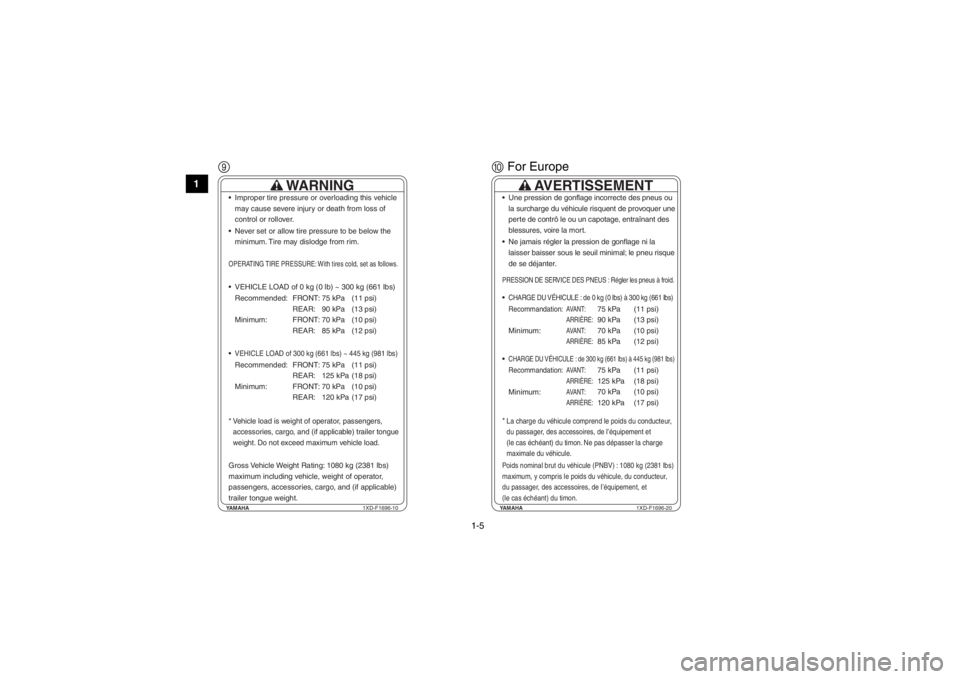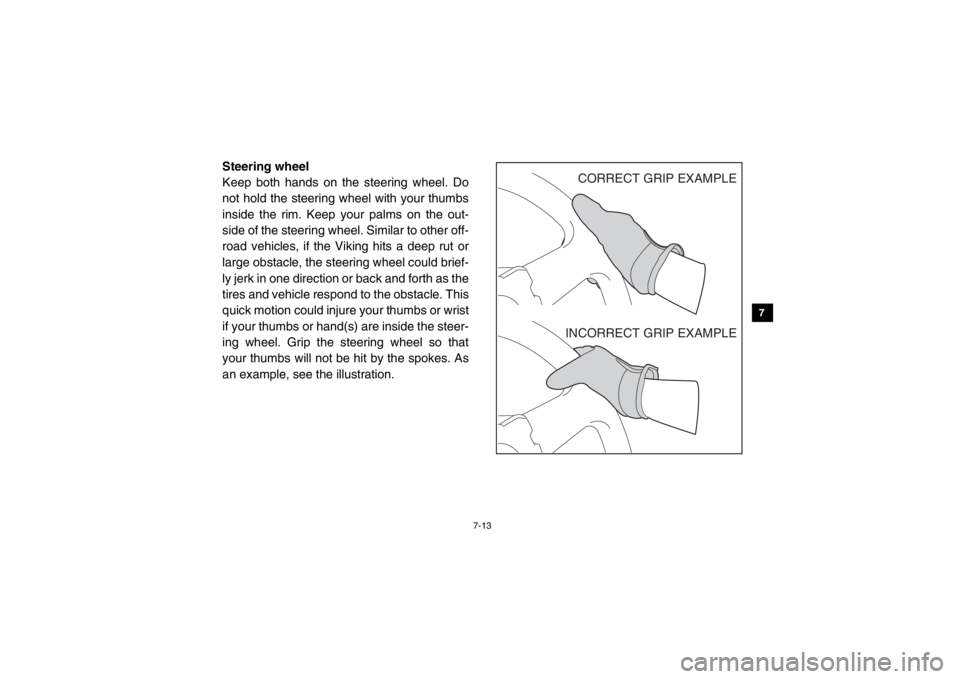tires YAMAHA VIKING 2014 Owners Manual
[x] Cancel search | Manufacturer: YAMAHA, Model Year: 2014, Model line: VIKING, Model: YAMAHA VIKING 2014Pages: 180, PDF Size: 3.78 MB
Page 7 of 180

Steering ........................................... 5-8
Fittings and fasteners...................... 5-8
Instruments, lights and switches ..... 5-8
Control cables ................................. 5-8
Tires ................................................ 5-8
OPERATION..................................... 6-1 Engine break-in ............................... 6-1
Starting the engine .......................... 6-2
Drive select lever operation and reverse driving............................... 6-4
On-Command drive knob................ 6-6
Parking ............................................ 6-8
Loading ........................................... 6-8
BASIC GUIDE FOR SAFE USE....... 7-1 KNOW YOUR VEHICLE................. 7-1
Driver requirements ........................ 7-3
Passenger requirements................. 7-4
Occupant protection system ........... 7-4
Protective structure ......................... 7-5
Seat belts ........................................ 7-6
Doors............................................... 7-9 Passenger handhold ....................... 7-9
Seat and shoulder bolsters............ 7-12
Floorboard ..................................... 7-12
Steering wheel ............................... 7-13
LEARNING TO OPERATE YOUR
VEHICLE ..................................... 7-14
Personal protective equipment...... 7-14
Practice for new Yamaha Viking users ............................................ 7-15
Getting ready to ride ...................... 7-16
Turning........................................... 7-16
Accelerating ................................... 7-17
Braking........................................... 7-18
Engine braking............................... 7-18
Leaving the vehicle ........................ 7-19
Parking on a flat area .................... 7-19
Parking on a slope ......................... 7-19
Loading .......................................... 7-20
Operation on different surfaces and terrains.................................. 7-20
Hills ................................................ 7-21
Uphill .............................................. 7-22
Downhill ......................................... 7-23
67
1XP7B_EE.book Page 2 Tuesday, February 4, 2014 3:40 PM
Page 14 of 180

1-5
1
2
3
4
5
6
7
8
9
10
11
12
13
14
90 For EuropeYAMAHA 1XD-F1696-10
WARNING
Improper tire pressure or overloading this vehicle
may cause severe injury or death from loss of
control or rollover.
Never set or allow tire pressure to be below the minimum. Tire may dislodge from rim.
VEHICLE LOAD of 0 kg (0 lb) ~ 300 kg (661 lbs) Recommended: FRONT: REAR:
Minimum: FRONT: REAR:75 kPa
90 kPa
70 kPa
85 kPa
VEHICLE LOAD of 300 kg (661 lbs) ~ 445 kg (981 lbs)Recommended: FRONT: REAR:
Minimum: FRONT: REAR:75 kPa
125 kPa
70 kPa
120 kPa (11 psi)
(13 psi)
(10 psi)
(12 psi)
(11 psi)
(18 psi)
(10 psi)
(17 psi)
*Vehicle load is weight of operator, passengers,
accessories, cargo, and (if applicable) trailer tongue
weight. Do not exceed maximum vehicle load.Gross Vehicle Weight Rating: 1080 kg (2381 lbs)
maximum including vehicle, weight of operator,
passengers, accessories, cargo, and (if applicable)
trailer tongue weight.OPERATING TIRE PRESSURE: With tires cold, set as follows.
YAMAHA 1XD-F1696-20
AVERTISSEMENT
Une pression de gonflage incorrecte des pneus ou
la surcharge du véhicule risquent de provoquer une
perte de contrô le ou un capotage, entraînant des
blessures, voire la mort.
Ne jamais régler la pression de gonflage ni la laisser baisser sous le seuil minimal; le pneu risque
de se déjanter.
CHARGE DU VÉHICULE : de 0 kg (0 lbs) à 300 kg (661 lbs)Recommandation:
AVANT:
ARRIÈRE:
Minimum:
AVANT:
ARRIÈRE:
CHARGE DU VÉHICULE : de 300 kg (661 lbs) à 445 kg (981 lbs)Recommandation:
AVANT:
ARRIÈRE:
Minimum:
AVANT:
ARRIÈRE:
(11 psi)
(13 psi)
(10 psi)
(12 psi)
(11 psi)
(18 psi)
(10 psi)
(17 psi)
75 kPa
90 kPa
70 kPa
85 kPa
75 kPa
125 kPa
70 kPa
120 kPa
*
La charge du véhicule comprend le poids du conducteur,
du passager, des accessoires, de l’équipement et
(le cas échéant) du timon. Ne pas dépasser la charge
maximale du véhicule.Poids nominal brut du véhicule (PNBV) : 1080 kg (2381 lbs)
maximum, y compris le poids du véhicule, du conducteur,
du passager, des accessoires, de l’équipement, et
(le cas échéant) du timon.PRESSION DE SERVICE DES PNEUS : Régler les pneus à froid.
1XP7B_EE.book Page 5 Tuesday, February 4, 2014 3:40 PM
Page 30 of 180

2-9
2
3
4
5
6
7
8
9
10
11
12
13
14
Aftermarket tires and rims
The tires and rims that came with your Viking were designed to match the performance capabili-
ties and to provide the best combination of handling, braking, and comfort. Other tires, rims, sizes,
and combinations may not be appropriate. Refer to page 8-40 for tire specifications and more in-
formation on replacing your tires.1XP7B_EE.book Page 9 Tuesday, February 4, 2014 3:40 PM
Page 64 of 180

5-2
5
6
7
8
9
10
11
12
13
14 Final gear oil/
Differential gear oil
Check for leakage. 5-7, 8-15, 8-17
Accelerator pedal Check for proper accelerator pedal operation. 5-7
Seat belts Check for proper operation and belt wear. 5-7
Passenger handhold Check for stability and proper fastening. 5-8, 7-9
Steering Check for proper operation. 5-8
Fittings and fasteners Check all fittings and fasteners. 5-8
Instruments, lights and
switches Check operation, and correct if necessary.
5-8, 8-49, 8-52, 8-53
Wheels and tires Check tire pressure and for wear and damage. 5-8, 8-39, 8-41
Axle boots Check for damage. 8-21
ITEM
ROUTINE PAGE
1XP7B_EE.book Page 2 Tuesday, February 4, 2014 3:40 PM
Page 70 of 180

5-8
5
6
7
8
9
10
11
12
13
14
A crash can damage the restraint systems in
your vehicle. A damaged restraint system
may not properly protect the person using it,
resulting in serious injury or death in a crash.
To help make sure your restraint systems are
working properly after a crash, have them in-
spected and any necessary replacements
made as soon as possible.Passenger handholdCheck that the handhold bar and its supports
are in good condition. Confirm that the locking
pins are securely fastened, and then push
and pull on the handhold to make sure that it
is not loose.EVU01230SteeringPark on level ground. Turn the steering wheel
right and left. Check for excessive free play,
abnormal noises, or a rough feeling. Have a
Yamaha dealer repair as necessary for proper operation.
EVU00470Fittings and fastenersAlways check the tightness of chassis fittings
and fasteners before a ride. Take the vehicle
to a Yamaha dealer or refer to the Service
Manual for correct tightening torque.Instruments, lights and switchesCheck that all instruments, lights and switches
are working properly. Correct if necessary.Control cablesWhen riding in cold weather, always make
sure all control cables work smoothly before
you begin riding. WARNING! Control cables
can freeze in cold weather and you could
be unable to control the vehicle.EVU00500TiresCheck tire pressure regularly to make sure it
is at the recommended specifications. Also
check for wear and damage.
1XP7B_EE.book Page 8 Tuesday, February 4, 2014 3:40 PM
Page 71 of 180

5-9
1
2
3
45
6
7
8
9
10
11
12
13
14
EVU00510Tire pressure
Use the tire pressure gauges to check and ad-
just tire pressures when the tires are cold. Tire
pressures must be equal on both sides.
WARNING! Operation of this vehicle with
improper tire pressure may cause severe
injury or death from loss of control or roll-
over. Tire pressure below the minimum
specified could also cause the tire to dis-
lodge from the rim under severe riding
conditions.
Set tire pressures to the following specifica-
tions:Recommended tire pressure:
Vehicle load:
0 – 300 kg (0 – 661 lb)Front:75 kPa (0.75 kgf/cm
2, 11 psi)
Rear: 90 kPa (0.90 kgf/cm2, 13 psi)
Vehicle load:
300 kg – maximum
(661 lb – maximum)Front:
75 kPa (0.75 kgf/cm2, 11 psi)
Rear: 125 kPa (1.25 kgf/cm2, 18 psi)
1XP7B_EE.book Page 9 Tuesday, February 4, 2014 3:40 PM
Page 97 of 180

7-13
1
2
3
4
5
67
8
9
10
11
12
13
14
Steering wheel
Keep both hands on the steering wheel. Do
not hold the steering wheel with your thumbs
inside the rim. Keep your palms on the out-
side of the steering wheel. Similar to other off-
road vehicles, if the Viking hits a deep rut or
large obstacle, the steering wheel could brief-
ly jerk in one direction or back and forth as the
tires and vehicle respond to the obstacle. This
quick motion could injure your thumbs or wrist
if your thumbs or hand(s) are inside the steer-
ing wheel. Grip the steering wheel so that
your thumbs will not be hit by the spokes. As
an example, see the illustration.
CORRECT GRIP EXAMPLE
INCORRECT GRIP EXAMPLE
1XP7B_EE.book Page 13 Tuesday, February 4, 2014 3:40 PM
Page 102 of 180

7-18
7
8
9
10
11
12
13
14
Braking
When slowing down or stopping, take your
foot off the accelerator pedal and press the
brake pedal smoothly. Improper use of the
brakes can cause the tires to lose traction, re-
ducing control of the vehicle and increasing
the possibility of an accident.
Braking ability is affected by type of terrain. In
most cases, gradual application of the brakes
is more effective than abrupt braking, particu-
larly on loose surfaces, such as gravel. Al-
ways allow for greater braking distance on
rough, loose, or slippery surfaces. Engine braking
Engine compression braking is designed to
assist you when operating your Viking off-
road. With this feature, the engine helps slow
the vehicle down after you take your foot off
the accelerator. Engine braking is more no-
ticeable in four-wheel drive. Application of ve-
hicle brakes provides additional stopping
power.1XP7B_EE.book Page 18 Tuesday, February 4, 2014 3:40 PM
Page 150 of 180

8-40
8
9
10
11
12
13
14
Tire replacementAlways use the same size and type of tires
recommended in this owner’s manual. The
tires that came with your Yamaha Viking were
designed to match the performance capabili-
ties and to provide the best combination of
handling, braking, and comfort. It is best to re-
place all four tires at the same time. If that is
not possible, you must replace the tires in
pairs (front or rear) with tires of the same size
and type as the originals. Never replace just
one tire.
WARNING
Installing improper tires on your Yamaha
Viking can affect handling and stability.
This can cause a loss of control.
The tires listed below have been approved by
Yamaha Motor Manufacturing Corporation of America for this model.
Front tire:Size: 25 × 8-12NHS
Manufacturer/model:
MAXXIS/MU09
Rear tire: Size:
25 × 10-12NHS
Manufacturer/model: MAXXIS/MU10
1XP7B_EE.book Page 40 Tuesday, February 4, 2014 3:40 PM
Page 173 of 180

10-3
1
2
3
4
5
6
7
8
910
11
12
13
14
Transmission:
Primary reduction system:
V-belt
Secondary reduction system:
Shaft drive
Secondary reduction ratio: 41/21 × 17/12 × 33/9 (10.142)
Transmission type: V-belt automatic
Operation:
Right hand operation
Reverse gear: 23/14 × 28/23 (2.000)
Low range: 31/16 (1.938)
High range:
30/21 (1.429)Chassis:Frame type:Steel tube frame
Caster angle:
3.7 °
Trail: 19.0 mm (0.75 in)Front tire:Type:
Tubeless
Size: 25 × 8-12NHS
Manufacturer/model: MAXXIS/MU09
Rear tire:Type:Tubeless
Size:
25 × 10-12NHS
Manufacturer/model: MAXXIS/MU10Loading:Maximum loading limit:
445 kg (981 lb)
(Total weight of rider, passengers, cargo, accessories,
and tongue)Tire air pressure (measured on cold tires):Recommended:Vehicle load:0 – 300 kg (0 – 661 lb):Front:
75.0 kPa (0.750 kgf/cm
2, 11 psi)
Rear: 90.0 kPa (0.900 kgf/cm2, 13 psi)
Vehicle load: 300 kg – maximum (661 lb – maximum):Front:
75.0 kPa (0.750 kgf/cm2, 11 psi)
Rear: 125.0 kPa (1.250 kgf/cm2, 18 psi)
Minimum: Vehicle load:0 – 300 kg (0 – 661 lb):
Front: 70.0 kPa (0.700 kgf/cm2, 10 psi)
Rear:
85.0 kPa (0.850 kgf/cm2, 12 psi)
1XP7B_EE.book Page 3 Tuesday, February 4, 2014 3:40 PM